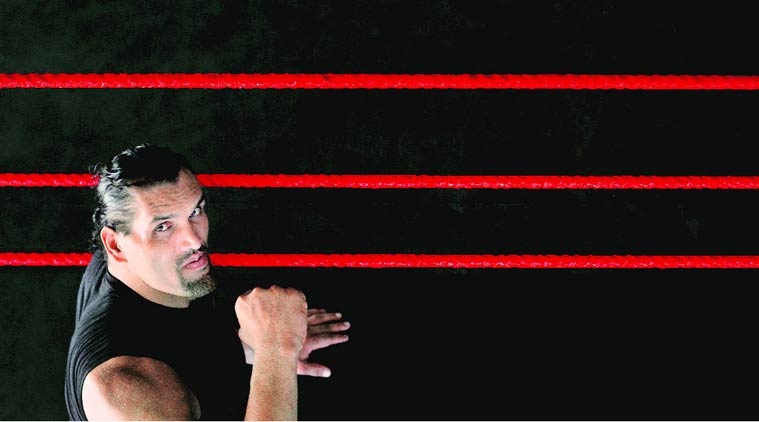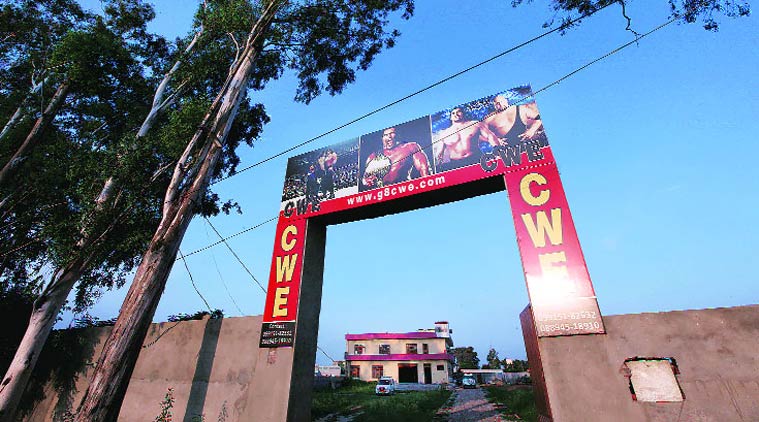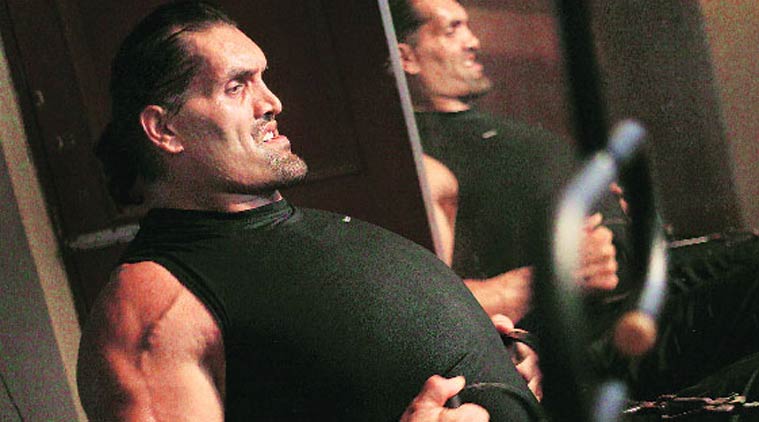The last slam: A year after his last WWE match, the life of ‘The Great Khali’ has turned a full circle
 Muscle power Khali at the academy he runs near Jalandhar for pro wrestlers.
Muscle power Khali at the academy he runs near Jalandhar for pro wrestlers.
Even if you know what to expect, your jaw drops when you meet Dalip Singh Rana. When he walks through a door, he has to twist his 7’ 2, nearly 200 kg frame a little. When he reaches for a handshake, you notice that his arm is the size of your waist. And when the man who wrestled as The Great Khali in the WWE (World Wrestling Entertainment) arena for nearly a decade grasps your hand in his dinner-plate-sized one, you feel like a child.
Rana hasn’t been The Great Khali for more than a year, since his contract with the WWE ended. He doesn’t have rights to the name either. It isn’t even his only ring name. In Japan, he wrestled as Giant Singh. In Mexico, he was Gigante Singh. If you were, however, an Indian with an iota of interest in pro wrestling, there is no other name you would know him by. Khali had fought with the best of the big guys — Triple H, Kane, The Undertaker and The Big Show — in the biggest of the shows. He was the first Indian pro wrestling superstar.
WWE or not, his popularity seems undiminished. When his Ford Fortuner stops at a police barricade in Jalandhar, the constable doesn’t ask Dalip Singh Rana for his licence. He grins and asks Khali for a photograph. “It’s only my family members who call me Dalip now. For everyone else I am Khali,” says the 42-year-old in a voice as guttural as his TV persona’s.
 On screen, Khali was billed as one who could walk unafraid amid tigers and pythons “in the jungles of Punjab”. These days, he’s found amid mustard fields, in a building where he runs his pro wrestling academy — the Continental Wrestling Entertainment (CWE) academy — about 20 minutes from Jalandhar. Set up six months ago, it is a work in progress. Unkempt grass surrounds the unfinished building. Labourers march in and out. The noise of machines is punctuated by the sound of bodies crashing at a boxing ring in the centre of the building.
On screen, Khali was billed as one who could walk unafraid amid tigers and pythons “in the jungles of Punjab”. These days, he’s found amid mustard fields, in a building where he runs his pro wrestling academy — the Continental Wrestling Entertainment (CWE) academy — about 20 minutes from Jalandhar. Set up six months ago, it is a work in progress. Unkempt grass surrounds the unfinished building. Labourers march in and out. The noise of machines is punctuated by the sound of bodies crashing at a boxing ring in the centre of the building.
A class is underway. Students form a line and practise body slams supervised by an American trainer, while Khali observes from a corner. The students are a mix of ages, shapes and backgrounds. There is a 6’2 bouncer from Goa. A strapping 6’10 ex-accountant rubs shoulders with a portly Delhi woman in her mid-thirties who goes by the name of Bibi Bulbul. An 11-year-old stands alongside a balding 26-year old who shut his kirana store in Jalgaon, Maharashtra. It wasn’t a cheap decision. The academy lets in anyone willing to have a go, but it charges Rs 15,000 a month. But there’s no shortage of applicants. Some 70 people are squeezed in two four-hour shifts. Every one of them hopes it’s just a few years before they wrestle in the WWE.
No one has made it yet. With such varying athleticism, results are mixed. It doesn’t help that the red-haired American, Rex Andrews, who wrestles for an independent promotion, doesn’t speak Hindi and the trainees mostly don’t understand English. His students have a long way to go before they can perform without injuring themselves. But he knows why they persist. “You have to be a dreamer to want to be a pro wrestler,” says Andrews.
 In 1998, Khali, one of seven children from an impoverished home in Dhiraina village in Himachal Pradesh, did not share that dream but he had nevertheless come a long way. As a teenager, he broke stones as a road worker to earn money. He had never been to school. His unusual height caught the attention of a police official, who got him a sports quota job with Punjab Police. There he found his niche in bodybuilding and competed successfully as a guest poser, who is paid simply to show up. But one day, the 26-year-old Dalip saw a telecast of the WWF. “I became a fan,” he says.
In 1998, Khali, one of seven children from an impoverished home in Dhiraina village in Himachal Pradesh, did not share that dream but he had nevertheless come a long way. As a teenager, he broke stones as a road worker to earn money. He had never been to school. His unusual height caught the attention of a police official, who got him a sports quota job with Punjab Police. There he found his niche in bodybuilding and competed successfully as a guest poser, who is paid simply to show up. But one day, the 26-year-old Dalip saw a telecast of the WWF. “I became a fan,” he says.
He did not know then that pro wrestling was a modern hybrid of pantomime — with good and bad guys. He did not know what it was to be the “heel”, the one who tried to get “heat” from the crowd with his villainy, or the babyface who played the hero. He was unaware of the fact that the match inside the ring or even the walk up to it could be used to tell a story, to entertain. “I thought the fighting was real. I felt I could beat everyone up. I knew this was what I should be doing with my life,” he says.
After a year, gathering the courage to leave a steady job, Khali travelled to Hayward, a town near San Francisco, California, to the All Pro Wrestling (APW) academy. Its promoter was Roland Alexander, a chartered accountant who found a second calling as a trainer on the independent circuit in America.
Money was tight. “I rented a room that was about 10 foot each side. I slept on the floor with my clothes and a hot plate,” he says. Language was a barrier, not just to grasping the technique of the sport but because pro wrestling is as much about working the crowd through the microphone as through ring craft. In one of his earliest promo tapes, where he is supposed to threaten an opponent, Khali, unable to growl anything more than “I Dalip wrestler”, finally cusses in Hindi before asking his opponent, “Kaunsi kheth ki mooli hai tu?”
There was neither glamour nor massive crowds on that circuit. “My first event was in a school gymnasium with less than a hundred people. I’ve performed in basements and at supermarkets. The crowd would be yelling and throwing things at you,” he says. Khali gritted it out. After a year, he got the opportunity to wrestle in Japan and later Mexico. The WWE — with its gaudy pageantry, worldwide audience and global stars — was still the dream. Strangely, it wasn’t his wrestling that caught the eye of the WWE in 2005 but his appearance as the giant inmate Turley in that year’s Adam Sandler prison football film, The Longest Yard. “The WWE rolled out the red carpet for me. They sent a limo, then took me out to lunch and finally [WWE CEO] Vince McMahon asked if I wanted to be on his team. I said yes,” Khali says.
 Just as Khali begins to talk about the pinnacle of his career, his attention is jerked back to the ring. Andrews is showing how to simulate punches. His wound-up strikes are glancing blows, dramatic but not dangerous. One trainee instead delivers hard short-arm cuffs, which can cause serious injury. As Andrews berates him, the overzealous puncher snaps back. Khali breaks things up as he often does at the academy, where some of the trainees still have to distinguish between actual fighting and pro wrestling.
Just as Khali begins to talk about the pinnacle of his career, his attention is jerked back to the ring. Andrews is showing how to simulate punches. His wound-up strikes are glancing blows, dramatic but not dangerous. One trainee instead delivers hard short-arm cuffs, which can cause serious injury. As Andrews berates him, the overzealous puncher snaps back. Khali breaks things up as he often does at the academy, where some of the trainees still have to distinguish between actual fighting and pro wrestling.
While the keyword is safety, wrestlers have to “sell” the move and receive what in pro wrestling parlance are termed “bumps” to convince the audience of its authenticity. Yet, any activity where human bodies are hurled like crash dummies is dangerous. Khali knows as much. Back during his APW days, Khali was demonstrating a spinebuster, a move that involves lifting an opponent by his waist and tossing him forward. Khali’s opponent was Brian Ong, a fellow trainee.
Ong had already suffered a concussion earlier but was told to continue training. When Khali performed the spinebuster, Ong grabbed his shirt. He hit the mat on his tailbone and whiplashed his head onto the surface. A few days later, Ong passed away. The accident wasn’t Khali’s fault and he wasn’t investigated, although the APW admitted their trainer’s negligence and settled with Ong’s family. “I was shaken up. It felt horrible but what could I have done? I wasn’t going to stop wrestling,” says Khali. But he never performed that move despite it being one that can sell a wrestler as a power performer.
Incidents such as this make Khali react strongly to sniggers about pro wrestling being “fake”. Yes, it isn’t real sport but the stakes are high. In one WWE match, Khali was supposed to get thrown from the second rope. Khali didn’t have a problem losing but was unsure of the safety of the move. It was ultimately decided that the match would end with Khali taking a spinebuster on the floor of the ring. Khali took the same “bump” — one of the hardest, he says — that he had seen claim a life from close up. All for the sake of entertainment.
Once in the WWE, Khali appeared to have joined at the right time. The industry works in cycles. For a while, the largest men get the best storylines till it is the time for the smaller, more technical purists to dominate. Khali, who got his ring name when Big Bhima and Great Shiva were ruled out, made his debut during the time of the big men. His promotion was a divisive choice. He had limited wrestling ability. His signature move, called a brain chop, was a forehand to an opponent’s head. His language weakness was initially explained away using the “wild Indian giant” gimmick. It meant that he never had the option of working the crowds with the microphone. In his defence, Khali was never meant to appeal to the purist but to the fan in the back of the stadium who wanted to be wowed by freakish size. His job was done simply by swaggering into the ring. Set to ominous “Indian” music, his slow stride to the stage in long trousers, with his massive torso bared, got little kids to drop their jaws. For Indian fans, such distinctions were irrelevant. Khali admits being astounded initially by the adulation and press coverage. “At first I collected newspaper clippings but stopped because there were so many. Once, I was told that people were praying to god ahead of my matches,” he says.
The prayers would have better been directed to Vince McMahon. After his first couple years in the business, Khali’s character stalled. Writers reintroduced him as “the Punjabi playboy”. In a TV segment known as the “kiss cam”, Khali had to kiss women wrestlers or women ostensibly chosen at random from the crowd. While the spectacle of beauty making out with the beast drew TRP points, Khali had gone from being chief villain to comic interest.
Khali’s roles would get sillier — he once came out in a pink “tooth fairy” costume. Towards the end of his career, he was the human equivalent of the largest dumbbell in a gym. Wrestlers the WWE wanted to hype would beat him, preferably using one of their signature moves. Khali says he never had a problem with the roles he was asked to play. “I never felt demeaned. As a professional, I did the best I could,” he says.
But Khali says he had plenty of great memories as well. “It is a magical feeling to perform for 50,000 people. You decide when they cheer and when they are quiet. It’s like you have them under your control,” he says. Khali had his most and least favourite crowds. “In the USA, the fans are passionate and are willing to believe in your character. But in China, the crowd was very polite but that way you don’t feel like doing much,” he says.
That pop from the crowd is why his favourite match wasn’t one he won but lost when John Cena threw him off a crane bed, in a move known as the FU. “A good match is about the chemistry between opponents. I loved working with Cena. He was always receptive to my ideas, even if they weren’t good. Because he was ready to try things, we delivered a great match. When we got backstage, McMahon hugged me and said I had put on a great show,” says Khali.
There were less successful matches as well. Early in his career, suffering from knee pain, he took a couple of painkiller pills as advised by another WWE star wrestler Randy Orton. “The pills were so strong that I couldn’t feel my legs. My foot kept slipping and I fell,” he says. Khali shares his stories freely at his academy hoping to deliver lessons about the importance of professionalism. “In this business, you can’t do without it. The hardest thing about the WWE is the travel. Each week, you leave home on Thursday, and for the next five days you are either catching a flight or driving to a venue or wrestling,” he says. Most wrestlers have a travel partner on the road and stay in one of the regional transportation hubs to make commuting easier. Khali originally stayed in Atlanta, Georgia and later Houston, Texas.
Fourteen years of that punishing schedule and the innumerable bumps have taken a toll physically. He underwent surgery in the USA to succesfully treat the pituitary malfunction that caused his gigantism. His joints, though, are another matter. A botched surgery in India on his right knee in 2005 has made it steadily worse. By the end of his career, Khali’s slow stride out to the ring evoked more sympathy than dread. Now 42, Khali has a prominent limp. The fact that he regularly works out his massive upper body makes the contrast with his weakened lower limbs far more apparent.
He has little self-pity, though. By the time his last three-year contract with the WWE ended, he was making a little under a million dollars a year. Now an American citizen, he runs a profitable liquor store in Houston. He and Harminder, his wife of 13 years, have an 18-month daughter, whose picture is his phone wallpaper and with whom he babytalks every evening.
It is obvious that Khali doesn’t need to motivate testy youngsters or run an academy, which despite its fees, is running on a loss. “But I want to. I still want to keep some connection with this industry. This was something I was born to do. I was always meant to be Khali,” he says. After training comes to an end in the evening, Khali switches on a big screen TV near the ring and tunes to a channel that exclusively shows WWE reruns. “I dream of wrestling all the time,” he says.
It’s a recurring dream. The music is playing and and he is hurrying on to the stage when he realises his trousers are missing. “And then I get up and I realise that I am not wrestling anymore. But I still keep my pants with me — both in India and in Houston. You never know,” he says.






WE ARE SO URGENTLY IN NEED OF KIDNEY DONORS FOR THE GRAND SUM OF $220,000.00 USD, CONTACT US NOW ON: silverline.kidneytransplant@gmail.com...(Whatsapp Number:+918050835190)

We are urgently in need of kidney donors for the sum of
$290,000.00 USD, Contact us now on email for more details.
(appolohospita1@gmail.com)
We are located in India
Dr. Walter Kumar
Kidney donor needed urgently, My client is urgently in need of a kidney transplant, If interested to sell contact here on my what'sApp number +4915219253693 Or Email: kidneydeal@gmail.com